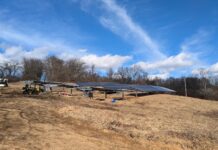There’s no doubt the nights have been colder. I’ve already started bringing my houseplants inside at night. If you haven’t started transitioning yours, now is the time.
After a long summer, with larger-than-usual insect populations, your houseplants will a little care before moving inside for the winter. You’ll need to account for less light and lower humidity and take preventative steps to stop any insects that want to hitch a ride. Taking the time to prepare your plants for the transition will help them thrive until next spring.
Plant preparation
Before bringing your houseplants indoors, you want to consider sprucing them up a bit and ensuring they are free of insects. First, remove any dead leaves or weakened branches. Next, give them a gentle shower to remove dust and dirt and dislodge aphids and mites that could be feeding on your plants. To make sure no insects burrowed into the soil through drainage holes, you can soak each pot in a tub of lukewarm water for about 15 minutes to force insects out of the soil. You want to try to avoid repotting if you can, but it may be necessary if snails, earthworms, or other insects burrowed in the soil. You want to skip soaking plants that prefer drier soils, such as cats or succulents.
House preparation
Because the conditions inside your home differ from the environment your plant is accustomed to, it’s important to try to reduce the differences as much as possible.
One of the biggest factors is light. Plants receive significantly more light outdoors. One way to increase their expose after they are moved inside is by cleaning your windows inside and out.
A second factor to consider is humidity. You may want to consider building a wide shelf that allows you to group plants together, or clear off a larger enough space for a group of plants in an area with adequate light.
Reducing plant stress
It’s important to reduce the amount of stress you’re putting on your houseplants as much as possible when transitioning them indoors. Sudden changes in temperature, light and humidity can result in yellowing leaves, dieback, wilting and even death in some cases. That’s why a gradual transition is so important.
You can start transitioning your plants by bringing them in only at night and putting them back outside during the day. You don’t want to leave houseplants outside anytime the temperature is below 45 F. When daytime temperatures are no longer acceptable, bring your plants in for the winter and choose the most well-lit location in your house.
- Isolation. Initially, you want to keep the newly acclimated plants away from any houseplants that remained indoors throughout the summer. You want to make sure no insects tagged along to prevent spreading them to other plants. Check under plant leaves and along stems for aphids, mites, scale and whiteflies.
- Lighting. Once you’re sure all your plants are pest-free, you can pick a more permanent location for them. You want to choose locations based on the light requirements of each plant. South- or west-facing windows will offer the most light. East-facing windows can accommodate plants with moderate light requirements. North-facing windows should be saved for shade-tolerant plant varieties. If you find there’s no natural light available in your home to accommodate your plants’ needs, supplement with fluorescents or grow lights.
- Humidity. The best way to increase humidity for houseplants is by grouping them together. When one plant loses moisture from its leaves, it increases the humidity around neighboring plants. You can also prevent plants from drying out by placing them away from furnace vents and heaters. For plants that require increased levels of humidity, you can place a trey lined with gravel underneath them and allow excess water to collect in it. Keeping them near your kitchen sink or in a bathroom can provide more humid conditions, as well.
- Temperature. Just as many plants can’t survive outside when temperatures dip too low, they can be stressed indoors when exposed to cold. Try to choose locations away from drafts and doors that open frequently.
- Watering and fertilization. You don’t want to overdo watering or fertilization. Plants grow slower in reduced light and don’t require as much water. If conditions outside are cloudy or rainy, plants won’t get enough light indoors to dry out. Let the soil surface dry out in between waterings. Similarly, many plants won’t need fertilizer until they begin actively growing again in the spring.













